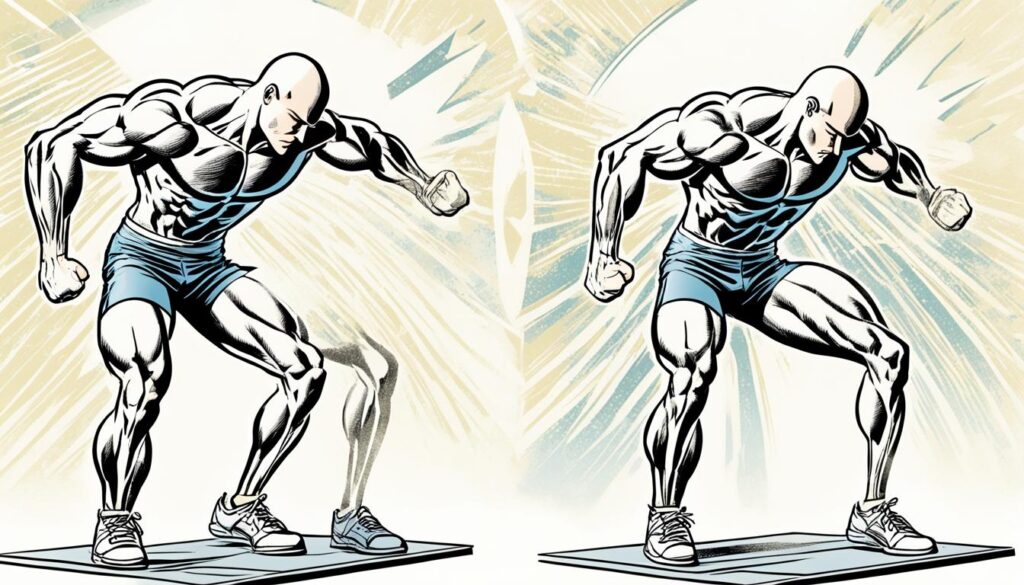Getting Started with front foot elevated split squat
Did you know that the gluteus maximus, the largest muscle in your body, is responsible for hip extension and plays a crucial role in overall lower body strength? Yet, many people struggle to effectively target and strengthen their glutes during their workouts.
If you’re looking for a new exercise to amp up your glute strength and improve your balance, look no further than the front foot elevated split squat. This single-leg squat variation not only activates your glutes but also engages your quads, hamstrings, and core, making it a total lower body workout all on its own.
Key Takeaways:
- The front foot elevated split squat is a highly effective exercise for targeting and strengthening your glutes.
- This exercise also engages your quads, hamstrings, and core, providing a comprehensive lower body workout.
- By challenging your balance, the front foot elevated split squat helps improve stability and proprioception.
- Proper form is crucial to maximizing the benefits of this exercise and preventing injury.
- Start with bodyweight and gradually increase weights to progressively challenge your muscles.
Why You Should Include Front Foot Elevated Split Squats in Your Workout
Incorporating front foot elevated split squats into your workout routine is a decision that your body will thank you for. This exercise is not only a great way to target your glute muscles but also provides a unique challenge that can help improve your overall balance.
Front foot elevated split squats are a variation of the traditional split squat, where one foot is positioned on an elevated platform or step. This simple modification increases the demand on your glutes, making them work harder to stabilize your body during the exercise.
By including front foot elevated split squats in your workout, you can achieve the following benefits:
- Improved Glute Strength: As you perform the exercise, your glute muscles are actively engaged to maintain stability and control throughout the movement. This increased load on the glutes can help develop stronger and more defined gluteal muscles.
- Enhanced Balance: Balancing on one leg while performing the front foot elevated split squat challenges your stabilizing muscles, including those in your hips, knees, and ankles. Over time, this exercise can improve your overall balance, making you more stable and less prone to injuries in other activities.
- A Total Lower Body Workout: Front foot elevated split squats target multiple muscles in your lower body, including your quadriceps, hamstrings, and calves. By incorporating this exercise into your routine, you can effectively work these muscle groups and achieve a more comprehensive lower body workout.
“Front foot elevated split squats are a fantastic exercise for enhancing glute strength and improving balance.”
Here is a step-by-step guide to performing front foot elevated split squats:
- Stand in a split stance with your front foot positioned on an elevated platform or step, and your back foot firmly on the ground. Ensure that your feet are hip-width apart and facing forward.
- Engage your core and maintain an upright posture throughout the exercise.
- Slowly lower your back knee towards the ground, keeping your front knee in line with your toes. Aim to lower your back knee until it hovers just above the ground.
- Push through your front foot and return to the starting position, maintaining control and balance throughout the movement.
- Complete the desired number of repetitions on one side before switching to the other leg.
Remember to start with lighter weights or bodyweight if you’re new to this exercise and gradually increase the intensity as your strength and stability improve.
Front foot elevated split squats are an excellent addition to any workout routine, whether you’re a beginner or an experienced fitness enthusiast. Not only do they target the glute muscles for strength and definition, but they also provide a challenge that can help improve your overall balance.
So, next time you hit the gym, consider incorporating front foot elevated split squats into your lower body workout. Your glutes will thank you!
How to Perform Front Foot Elevated Split Squats for Beginners
If you’re new to front foot elevated split squats, don’t worry! I’m here to guide you through the proper technique, specifically catered to beginners. This exercise is a fantastic way to improve glute strength and balance, so let’s get started!
Step-by-Step Instructions:
- Begin by standing in a split stance, with one foot positioned in front of the other. The front foot should be elevated on a stable platform, like a step or bench.
- Keep your chest up and shoulders back, engaging your core for stability throughout the exercise.
- Slowly lower your body by bending your knees, focusing on a controlled movement. The back knee should be lowered towards the ground, keeping the front knee directly above the ankle.
- Pause briefly at the bottom of the movement, then push through the front heel to return to the starting position.
- Repeat the movement for the desired number of repetitions, then switch legs and perform the exercise with the other leg in front.
Remember, it’s important to maintain proper form throughout the exercise to maximize its benefits. Here are a few additional tips for beginners:
- Start with a lighter weight or no weight at all to focus on mastering the movement and building stability.
- Place your hands on your hips or extend your arms forward for added balance and support.
- Perform the exercise in front of a mirror to monitor and correct your form.
- Gradually increase the weight as you become more comfortable and confident in your technique.
By following these instructions and tips, you’ll be able to perform front foot elevated split squats with ease and confidence, improving your glute strength and balance along the way.

Now that you know how to perform front foot elevated split squats for beginners, it’s time to incorporate them into your workout routine. Remember to always prioritize proper form and gradually increase the weight as you progress. Stay consistent, and you’ll soon reap the benefits of this effective lower body exercise.
Front Foot Elevated Split Squats for Female Athletes
When it comes to improving lower body strength, enhancing performance, and addressing specific concerns, front foot elevated split squats are a game-changer for female athletes. This exercise targets the glute muscles, improves balance, and helps build functional strength, making it an essential addition to any training regimen.
Female athletes often face unique challenges when it comes to strength training. Anatomy, hormonal differences, and biomechanics can all impact performance and muscle development. Front foot elevated split squats specifically address these concerns, allowing female athletes to target the glutes while improving stability and coordination.
The Benefits of Front Foot Elevated Split Squats for Female Athletes
- Glute Strength: Female athletes often struggle with activating and strengthening their glute muscles, which play a crucial role in performance and injury prevention. Front foot elevated split squats provide targeted activation to build glute strength and power.
- Better Balance: Balance is essential for athletes across various sports. Front foot elevated split squats challenge athletes to stabilize their bodies and develop better balance, improving overall performance on and off the field.
- Injury Prevention: Strong glutes can help prevent common knee and hip injuries that females are more prone to. By incorporating front foot elevated split squats into their training routine, female athletes can build functional strength to support their joints and reduce the risk of injury.
To perform front foot elevated split squats, follow these steps:
- Stand in a split stance with one foot elevated on a step or platform behind you.
- Lower your body into a lunge position, ensuring your front knee stays aligned with your ankle.
- Push through your front heel to return to the starting position.
- Repeat on the other side.
Remember to maintain proper form throughout the exercise, keeping your chest up and core engaged. Start with body weight or light dumbbells and gradually increase resistance as you become more comfortable and confident with the movement.
Expert Tip: Balancing with BOSU
Adding a BOSU ball to your front foot elevated split squats can further challenge your balance and core stability. Place the flat side of the BOSU ball on the ground, stand on the domed side with one foot elevated, and perform the exercise as usual. This variation engages more muscles and enhances the benefits for female athletes.
Now that you understand the benefits of front foot elevated split squats for female athletes, it’s time to incorporate this exercise into your training routine. Remember to consult with a fitness professional or coach to ensure proper form and modifications tailored to your specific needs.
Conclusion
In conclusion, incorporating front foot elevated split squats into your workout routine can be highly beneficial for enhancing glute strength and improving balance. Whether you’re a beginner looking to kickstart your fitness journey or a female athlete striving for peak performance, this exercise offers a great way to challenge your lower body and achieve your fitness goals.
When performing front foot elevated split squats, it is crucial to maintain proper form and technique throughout each repetition. Start with a beginner weight and gradually increase the load as your strength improves. This will help prevent injuries and ensure optimal results from your workout.
Additionally, remember that a well-rounded approach to your fitness routine goes beyond just exercise. To support muscle growth and recovery, it’s important to fuel your body with a balanced diet that includes sufficient protein. This will provide the necessary nutrients to repair and strengthen your muscles, aiding in overall performance and progress.
So, don’t hesitate to give front foot elevated split squats a try in your next workout session. Whether you’re aiming to build glute strength, improve balance, or enhance overall fitness, this exercise offers a versatile and effective way to achieve your desired results. Start incorporating it into your routine today and unlock the potential for a stronger, more balanced body!
FAQ
What are the benefits of adding front foot elevated split squats to my workout routine?
Front foot elevated split squats are a great exercise for enhancing glute strength and improving balance. This exercise specifically targets and activates the glute muscles, helping to develop a stronger and firmer rear end. Additionally, front foot elevated split squats require stabilization and balance, which can lead to better overall lower body stability and control.
How can front foot elevated split squats help with glute strength?
Front foot elevated split squats primarily work the gluteus maximus, the largest muscle in the glute complex. By incorporating this exercise into your routine, you can effectively target and engage your glutes, helping to increase strength and develop a toned, sculpted appearance. It’s a fantastic exercise for those who want to build a stronger and firmer butt.
Are front foot elevated split squats suitable for beginners?
Yes, front foot elevated split squats can be modified for beginners. If you’re a beginner, start with a lighter weight or no weight at all and focus on nailing the proper form and technique. It’s also helpful to position your elevated foot on a lower platform or step to reduce the range of motion. As you become more comfortable and confident, you can gradually increase the weight and intensity.
Can female athletes benefit from incorporating front foot elevated split squats into their training?
Absolutely! Front foot elevated split squats are highly beneficial for female athletes. Not only do they target the glute muscles, which are crucial for power, stability, and agility, but they also help address common imbalances and weaknesses that women may experience. By adding this exercise to your routine, you can improve lower body strength, enhance athletic performance, and reduce the risk of injuries.
